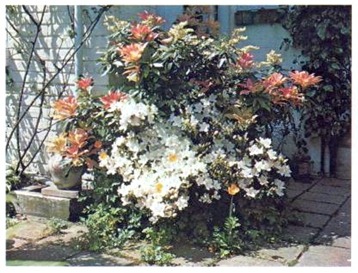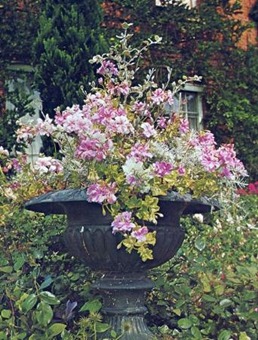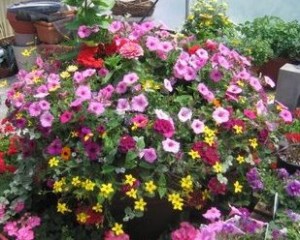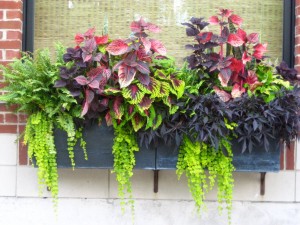





Old sinks used as containers for rock garden plants have already been discussed as a way of containing a very specialist type of garden in a very small space. ‘Containerised’ plants of other types have many advantages too. They can be moved around to give different effects; things looking their best come to the front while those that have gone over can be put out of sight entirely. Both permanent and seasonal plants can be used. A well-chosen shrub, though necessarily of smallish size, which may be fine enough in the open garden gains an added dimension when growing in a suitable container. It becomes placed on a pedestal; branches which normally brush the soil or get mixed up with lower-growing plants hang elegantly over the edge.

A favourite tub of mine for ten years before the wood disintegrated held one plant of Pieris forrestii and another of a dwarf, white azalea, Rhododendron mucronatum. For weeks in spring it was a most arresting sight; first brilliant scarlet new growth and flowers of the pieris, and then as these were fading the azalea took over. Then, in early summer I always planted a couple of morning glories (ipomoea) to clamber in the branches and hang out those incredible blue, trumpet-like blooms. Even when these were done the two original shrubs were tidily evergreen throughout the winter. And all this in a 60 cm (2 ft) high tub made of marine plywood. Such an example shows at once a further advantage of container gardening: a difficult soil is no longer a bar to growing anything. Here lime-haters flourished in a chalky area in prepared compost.
 The range of containers available is enormous; from antique urns in stone and lead to simple flower pots. Few people have pockets deep enough for the former but very acceptable reproductions of traditional shapes are made in reconstituted stone or glass fibre. It is necessary, however, to be sure that the interior is large enough to hold sufficient soil to allow plants to flourish. Without this the container has to become an ornament in its own right and its visual quality must be really good as it must do without plant growth to help it along.
The range of containers available is enormous; from antique urns in stone and lead to simple flower pots. Few people have pockets deep enough for the former but very acceptable reproductions of traditional shapes are made in reconstituted stone or glass fibre. It is necessary, however, to be sure that the interior is large enough to hold sufficient soil to allow plants to flourish. Without this the container has to become an ornament in its own right and its visual quality must be really good as it must do without plant growth to help it along.
Frequently the modern simple shapes of asbestos or concrete (often known as planters) are more in keeping with a contemporary patio. Again, soil depth is apt to be insufficient. Those great saucers There is no lack of good containers for garden decoration. Classical shapes in modern materials; reconstituted stone and fibre glass (for few of us can afford the real thing) are still among the best so long as there is sufficient depth for good root growth. Here is a random selection.
Look well enough but it is not easy to keep plants growing happily in them. On a larger scale are circular concrete sewer pipe sections, these are almost raised beds in themselves. They lose the virtue of mobility but can look splendidly architectural set into cobbles or granite sets. The sides, of course, can be ‘Snowcemmed’ to tone with adjacent buildings or walls.
Containers do not have to be so specialised. It is easy to make them using rot-resistant marine plywood. Half barrels are frequently used and old-fashioned breadcrocks are still sometimes available. In all cases drainage must be perfect. If it is not, holes will have to be drilled so excess water can drain away. Terracotta or earthenware can be drilled with an electric drill; a ring of small holes is made and then the centre, an inch or two in diameter, carefully knocked out.
Container gardening is a concentrated form of gardening. Obviously, if plants are to remain healthy for years together, a clear feeding regime must be followed. Firstly the soil must be right.
If only a couple of pots are in question it is not too extravagant to buy a prepared compost. John Innes Potting Compost No 3 would be suitable; the texture is open and it releases nutrients over a long period. On a larger scale it is necessary to mix one yourself. The John Innes Potting Compost recipe is 7 parts by volume of sterilised loam 3 parts by volume moss peat 2 parts by volume coarse grit fertiliser additive — 1kg per cubic metre (2lb per cubic yard) The same basis applies for a home mix, the peat and grit (not builder’s sand, it is too fine) are easily bought, loam will have to be the garden soil. However, if this is intractable clay, very thin sand or full of lumps of chalk, then a better source must be found. A mix of six parts of garden soil, three parts of peat and two parts of grit is probably right, plus 1kg (2lb) of John Innes Fertiliser base to each cubic metre (cubic yard) of soil.
A container holding a single shrub to give year-round effect can usually be helped by the addition of a few bulbs planted in October to give spring interest and when these are over they can be removed and a few summer annuals put in their place.
The choice of the main plant is important, after all it is in view for much or all of the year. The ideal shrub would offer a good general appearance, exciting, scented flowers and edible, ornamental fruit. This paragon does exist in the shape of citrus trees — though they are not for chilly northern European gardens. It does explain, however, the virtual obsession for oranges and orangeries in times past. Still, even today, a single fruiting bush can be produced, if heated greenhouse space is available, which can be stood out of doors in the summer.
However, if all the desiderata cannot be had in one plant it becomes necessary to lower one’s sights a little. Length of interest is a prime consideration, combined with the ability to accept confined conditions and occasional, accidental neglect. This last fact is why camellias (otherwise ideal with their fine foliage and exquisite flowers) are seldom successful: one dry period in late summer is all that is needed for all next year’s flower buds to fall.
General shape and leaf effect is important to complement the architectural setting in which most containers are arranged.
In a shady spot Fatsia japonica or a Japanese maple have distinctive foliage; while in the sun, yuccas, particularly the variegated forms, and New Zealand flax (phormium) are most striking. Hebes give flower over a long period and their elegant foliage is held throughout the year except in the harshest weather.
 For most people tubs and pots in the garden indicate riots of summer flowers. And what a choice there is. Again it is best to choose those types that develop a good shape, for example petunias make a great deal of growth which cascades down the side of the pot, doubling its size and effectiveness. Avoid tight little upright plants like French marigolds which will stand at attention like so many Lilliputian soldiers in orange hats.
For most people tubs and pots in the garden indicate riots of summer flowers. And what a choice there is. Again it is best to choose those types that develop a good shape, for example petunias make a great deal of growth which cascades down the side of the pot, doubling its size and effectiveness. Avoid tight little upright plants like French marigolds which will stand at attention like so many Lilliputian soldiers in orange hats.
If the container is big enough, a mixture of foliage and flowering plants can be used. A central Senecio cineraria surrounded by geraniums, or a mound of fuchsias mixed in with Helichrysum lanatum. Remember that in most areas early June is soon enough to put these tender plants outside, although shops and garden centres have them on sale from Easter to trap the unwary. However, if even an unheated conservatory is available the summer show can be bought, potted separately, and got moving before being planted out. On a smaller scale the bathroom or kitchen window sills can be commandeered for May.
Generous planting is the rule, those near the edge should lean outwards to encourage the cascading effect and give more room at the top. Putting half the garden down to summer bedding is now extremely expensive, as well as being out of tune with modern trends. So concentrate these plants in a few containers grouped together, rather than strewn about. This will look more effective, be less time consuming and not so costly.
What to do when the autumn frosts kill the tender sub-tropicals? People with some conservatory space or even a space in the spare bedroom should take cuttings of all but the true annuals in September and pot up a few geraniums. This will leave the containers empty. However a normal spring-bedding programme can be followed with November-planted tulips, daffodils or even hyacinths mixed with wallflowers and similar plants. But they are apt to look forlorn in a prominent position, such as beside the front door. A couple of containers could be used in this way and put somewhere sheltered until they are at their best in April. If a few pots of ivy are kept sunk in a corner of the garden throughout Summer, these can come into their own each November to fill the important front-of-the-house containers.
 All these remarks apply also to window boxes which are, in fact, elongated containers with a rather specific job. Here it is even more important to choose cascading plants; the effect is delightful from the outside and from inside the window the view is not just of a forest of stalks. In the garden it is natural to choose container plants to suit the area concerned. With window boxes the frame of the building and the room indoors must be considered. Avoid, for instance, scarlet geraniums against a red-brick house; choose scented flowers if the window is opened on sunny days or even more specifically plant herbs in the kitchen window box.
All these remarks apply also to window boxes which are, in fact, elongated containers with a rather specific job. Here it is even more important to choose cascading plants; the effect is delightful from the outside and from inside the window the view is not just of a forest of stalks. In the garden it is natural to choose container plants to suit the area concerned. With window boxes the frame of the building and the room indoors must be considered. Avoid, for instance, scarlet geraniums against a red-brick house; choose scented flowers if the window is opened on sunny days or even more specifically plant herbs in the kitchen window box.
This is even more important than those in the open garden as their reserves of food and especially water are bound to be low. Permanent plants will require fortnightly liquid feeds from April to September. If any plant looks particularly unhealthy after the winter apply a foliar feed. Plants in window boxes and pots of annuals will enjoy a weekly feed during the summer. Water, of course, must be adequate; and this means daily in hot spells when pots are full of root.
All this indicates that care must be taken with the amount of plants in a container and the siting of them. Avoid window boxes that are difficult to water or tubs positioned far from a tap. Consider how the plants will fare if you are always away for a long summer holiday. However, if well used the concentration of colour or architectural effect from this type of gardening is well worth the trouble.
Copyright © www.100flowers.win Botanic Garden All Rights Reserved